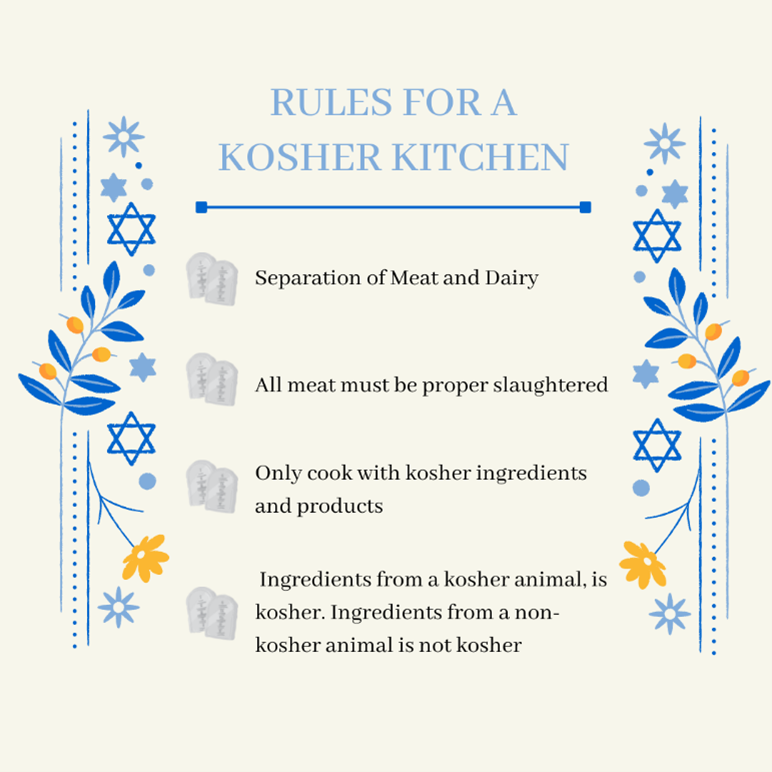Table of Contents
When describing a kosher kitchen, there is a lot of information that needs to be explained. Kosher is not like one of the dozens of trending interior design options, it’s a lifestyle someone undertakes by following strict rules laid out by their religious doctrine.
Who practices kosher?
The Jewish community are the main practitioners of having a kosher meal and having a kosher kitchen. They recognize and actively exercise adhering to the strict laws informed by their Rabbi who shares the information from the Torah.

What is kosher?
Kosher comes from the original Hebrew word “kasher” meaning “fit” or “to make fit for use.” Simply put, kosher references Jewish foods that fit a dietary framework and that are specifically prepared, processed and consumed.
Rules for Kosher Kitchen
For a meal to be considered kosher, it needs to be prepared by implementing the following rules.
- Separation of Meat and Dairy: There must be a complete separation of meat and dairy products. They cannot be prepared, served, or eaten at the same time. This extends to utensils and appliances as food that has touched meat or dairy cannot be used for the other.
- Properly Slaughtered: All meat must be properly slaughtered by using an extremely sharp knife to slit the throat of the animal in a specific technique which minimizes pain and stress.
- Ingredients: Ingredients that come from a kosher animal are considered kosher. Ingredients from a non-kosher animal are not considered kosher.
There are multiple forms of Judaism and some variations existing on how to interpret kosher rules, but most often these are the standard in practice.

Kosher Jewish Foods:
Having kosher food entails only specific animals can be eaten once properly made.
- Mammals: Land animals must have cloven (split) hooves and must chew cud (a partly digested food that has returned to the mouth from the stomach for continued chewing). Such examples are cows, goats, bison, sheep, oxen, and deer.
- Poultry: The most commonly accepted birds considered kosher are chickens, turkeys, ducks, geese and pigeons. Different references in the Torah provide multiple examples, but a common consensus is a bird must not be a bird of prey. It also mentions kosher birds have: the presence of a crop, an extra finger, and a gizzard that can be peeled. Eggs are considered kosher if they come from one of the birds considered kosher. Eggs must be thoroughly inspected to confirm there are no drops of blood.
- Fish: Fish must have fins and scales. Water-dwelling creatures that do not meet these criteria, like crab, lobster, shark and squid are prohibited.
- Fruits and Vegetables: All unprocessed fruits and vegetables are considered kosher if they were not sprayed with pesticides. Insects are non-kosher, so fruits that attract these animals need to be thoroughly examined. Honey is sometimes considered kosher despite bees being non-kosher.
What is a kosher kitchen?
What does it mean to have a kosher kitchen? A kosher kitchen is one that has been certified by a Rabbi declaring the kitchen is following all the guidelines set by kosher kitchen rules. This often requires separate utensils, accessories and that everything is adequately separated and cleaned. Any non-kosher ingredients have been properly disposed.
What makes a kitchen kosher?
If someone was transitioning into Judaism and wanted to adopt kosher kitchen etiquette, then they must clean their kitchen physically and spiritually.
- Remove Non-Kosher Products: Remove all non-kosher products from the kitchen. Canned goods, foods with combination meat and dairy, pork, sections of meat coming from the hindquarters of the animal and products made by non-Jewish manufacturers.
- Clean Everything: Sink, refrigerator, cooktop, oven, countertops, cabinets, floor; everything that has been touched or will be touched by food needs to be scrubbed clean.
- Wait 24 Hours: This waiting period allows the now cleaned kitchen to rest. By allowing a full 24 hours to pass, this allows the non-kosher material to be released into the air.
- Koshering the Objects: This step involves a Rabbi coming to burn away any residue on all metal objects. This process is commonly used with a blowtorch or pouring boiling water on the object. Some self-cleaning ovens have a setting which performs a high-heat cycle which is accepted. This process should only be done by a trained professional as improper timing could damage the appliance.
Kosher Kitchen Requirements
In order to ensure complete separation of meat and dairy, the kitchen can be designed a few ways to guarantee all kosher standards are met. Designs can always change depending on what you want your kitchen to look like and there are no rules for what color scheme, but many modest Jewish families enjoy a warm and comforting feeling to their homes. By employing dark, pastel colors like red, orange or apricot, you can give your kitchen a colorful and comforting space.
Utensils & Tableware: When it comes to utensils and dinnerware, the best practice is having different set of utensils for both meat and dairy. Having a pair of everything makes it easier to prepare each ingredient without the risk of mixing. Many kosher families adopted a coloring system on their utensils for better visual clarity. A common color-coded organizational system is; meat is red, dairy is blue; and neutral foods are green or yellow.
Sink: When remodeling a kitchen, it would be wise to consider installing a second sink to ensure near complete separation of meat and milk products. Meat and milk cannot be cleaned in the same areas as well, so having a separate sink specifically for each ingredient minimizes the accidental chance of mixing a meat fork with a dairy spoon. It is possible but ill-advised to use a single sink, but the sink must be thoroughly cleaned and must be left to rest for 24-hours before it can be used again. Other optimal options are a two-bowl sink or a main sink with a smaller prep sink.
Cabinet Spacing: Having additional appliances and utensils requires much more cabinet space. It’s recommended to use drawers with matching colors according to the implemented code being utilized. For kitchens with smaller space, use different drawers in a single cabinet or dedicate individual shelves and drawers to specific utensils.
Appliances: Purchasing 2 appliances for meat and dairy will be the most effective way to avoid cross contamination when prepping and cooking food. Food residue from steam may often stick to the sides of an oven or microwave, which can mix with the other ingredients. Buying two ovens, two microwaves, and 2 dishwashers will ensure complete separation of meat and dairy when properly labelled.
Refrigeration: Refrigeration can be a bit tricky since meat and milk need to stay cold to remain fresh. If you have the space to own 2 refrigerators, than that would be ideal. An alternative would be a main fridge for meat products and a smaller under-cabinet fridge for dairy. It is possible to use 1 refrigerator, as long as everything is clearly labelled and on separate shelves. In case something spills, the shelves need to carefully be taken out and cleaned thoroughly.
Keeping a Kitchen Kosher
Having a kosher kitchen extends outside the confines of the actual kitchen. There is also a process on how to serve the food and meal preparation. Knowing these basic guidelines will help keep your kitchen and home kosher.
- Table Etiquette: Meat and dairy cannot be served together or be present on the same table serving food. When transitioning from meat to dairy or vice-versa, the tablecloth, dishes and cutlery must be changed, and the table fully cleaned.
- Ovens: Ovens should be designated as either meat or milk use.
- Cleaning: Use separate sinks to clean and maintain your separation standards. Have individual racks for plates and utensils to dry. A dishwasher can be used for either meat or dairy.
- Cabinets: Store food on different shelves and thoroughly clean any spills to avoid contamination.
- Organization: Incorporate a simple color-coding structure or organizational system to differentiate between meat and dairy utensils and appliances.
















 The article helped me immensely
The article helped me immensely
 I’m now more informed on the subject
I’m now more informed on the subject
 I have questions about Marble.com
I have questions about Marble.com
 The article was not accurate at all
The article was not accurate at all
 There is a serious lack of information
There is a serious lack of information
 I have questions about Marble.com
I have questions about Marble.com